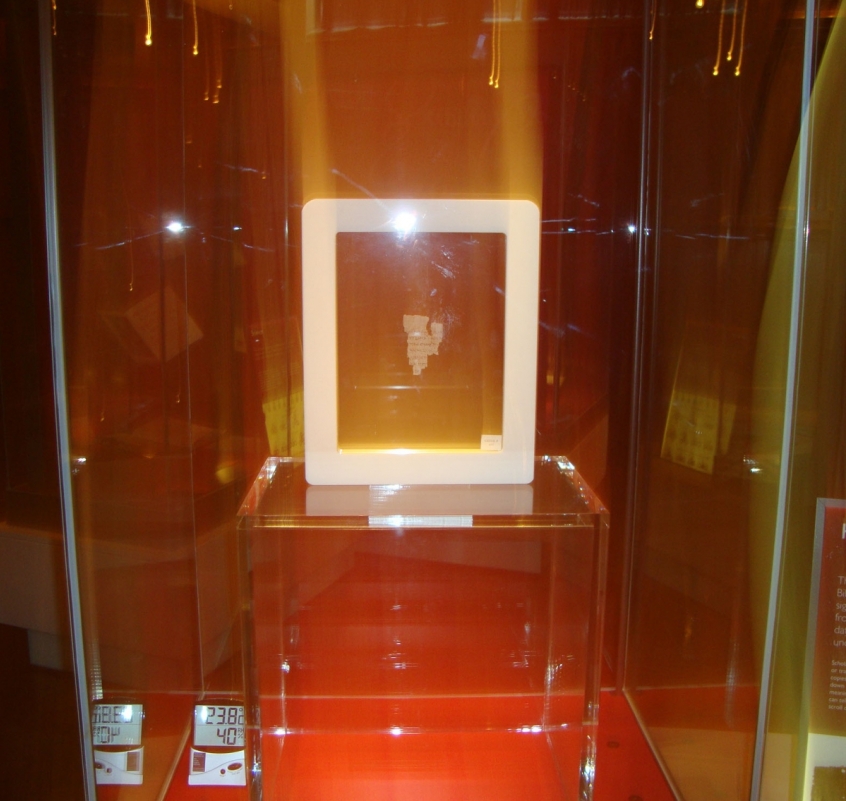In February 2012 the orthodox New Testament scholar Daniel B Wallace was involved in a public debate with a biblical-scholar-turned-unbeliever, Bart D Ehrman. During the debate Wallace made the public announcement that he had seen a fragment of the text of the Gospel of Mark which dated from the first century AD.
This was a sensational declaration because the oldest known fragment of the New Testament so far is a snippet of John's Gospel from the first half of the second century AD. This little manuscript is in the John Rylands Library in Manchester and is commonly known as P<sup>52 or Papyrus 52. (The originals of the books of the Bible have not been preserved and what we have are numerous copies from later dates. But none of them dates form the 1st century AD and few from the 2nd.)

Rumours
During and after the debate Wallace was unable to say more about the manuscript because he had signed an agreement to secrecy, something rather unusual in biblical scholarship, presumably with the owner of the manuscript. Regardless, many rumours about the newly-discovered text began to circulate. Allegedly some other scholars had also been able to look at it briefly, yet without the opportunity to take pictures, among them Craig A Evans. One story said that the papyrus had been preserved because it had been used as stuffing in the mask of a mummy somewhere in Egypt. The famous American apologist Josh McDowell also referred to the manuscript. Others claimed that it was up for sale and that the Green family, known from the Museum of the Bible, were likely to obtain it. The manuscript got its own acronym, FCM, for First Century Mark.
As time went by, people understandably lost patience. Something as important as a very old biblical manuscript should be published without delay so that everyone would be able to study and comment on it. Critical scholars and atheists began to ridicule the entire affair. Was there such a thing as FCM after all?
From Oxyrhynchus
Well, yes and no. Rather unexpectedly, this month the publication of the manuscript was announced. The honour of breaking the news goes to the young textual scholar Elijah Hixson who blogs on the website Evangelical Textual Criticism. The reality is not as good as the rumours, though. There is an old fragment of Mark, but since they first studied it, the experts have changed their mind and they now date it to between AD 150 and 250. So it's not a FCM after all! The time around AD 200 is of course still a very long time ago, but it does mean that this fragment of the New Testament is not the oldest; that honour remains with the fragment of John in Manchester.
The fragment is about to be published in a bulky scholarly book: Volume 83 of The Oxyrhynchus Papyri, which like the previous 82 volumes is published in Oxford. Let me explain.
Between the years 1896 and 1907, the British archaeologists Bernard Grenfell and Arthur Hunt made the largest discovery of ancient manuscripts ever recorded, in the local garbage heap of the city of Oxyrhynchus in Egypt. The thousands of texts they recovered made their way to Oxford and have been there ever since. With intervals of a few years, volumes of The Oxyrhynchus Papyri bring a number of 'new' manuscripts in the public domain but progress is slow.
We now know that the fragment of Mark was not found in a mummy and that it is not in the USA, but that it is one of the many papyri which were discovered in Oxyrhynchus, probably in 1903 to be exact. It has thus been sitting in a basket in Oxford for over a hundred years. The people responsible for The Oxyrhynchus Papyri understand very well that their 83<sup>rd volume will attract much attention. They have taken the unusual step of putting the relevant pages online. However, the pictures visible there cannot be reproduced here or anywhere else for copyright reasons. In the meantime, many baskets full of unpublished manuscripts remain to be sorted and published in Oxford, but those in the know have now declared that among this material there are no biblical manuscripts dating from before AD 200.
Apologies
Daniel Wallace immediately apologised openly and unreservedly, not least to Bart Ehrman. He is sorry that, on the basis of incorrect information, he said things which have turned out to be inaccurate.
Someone who has so far remained silent is Dirk Obbink. Despite his Dutch family name Obbink is an American papyrologist who works with the Oxyrhynchus Papyri in Oxford. This month's publication of the fragment of Mark in The Oxyrhynchus Papyri is his work. And it was he who initially dated the manuscript to the first century AD back in 2012, although he now rather thinks it was around AD 200. There also stubborn rumours that he put the manuscript up for sale to some rich Americans like the Green family, although it is of course not his personal property at all.
Importance
So what is being published and what is its relevance? It's a piece of papyrus measuring no more than some four by four centimeters, badly worn and torn. On the front it contains some words from Mark 1: 7-9 and at the back it has parts of Mark 1: 16-18. The fact that there is writing on both sides tells us that it comes from a book rather than from a scroll: scrolls only had writing on one side of the material. The letters are not too hard to read. The copyist made an attempt at calligraphy but was not entirely successful.
This manuscript has been given the number P.Oxy. 5345 and it will also be known as P<sup>137, the 137st papyrus of the New Testament. (On top of these 137, we have countless manuscripts on parchment which are generally younger.)
P<sup>137 is the oldest-known manuscript of the Gospel of Mark, because the one which was so far the oldest (one of the Chester Beatty papyri in Dublin, known as <sup>P45) dates from the third century and what remains of it only begins somewhere in Mark 4. It is striking that on P<sup>137 in verse 17 the name Jesus is missing; instead of it we can read 'he', so this difference does not affect the meaning of the text. Despite the many human mistakes which preceded its publication, this new fragment does contribute to our confidence in the reliability of the text of the New Testament.
As an aside, in the very same Volume 83 of the Oxyrhynchus Papyri you also find the publication of a new fragment of Luke 13, P.Oxy. 5346, which will become known as P<sup>138.
Rev Dr Pieter Lalleman is a tutor in Biblical Studies at Spurgeon's College.













